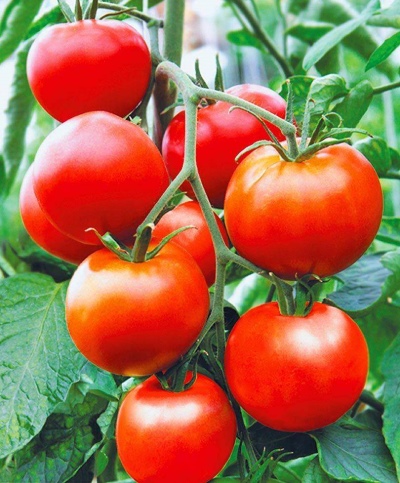
- Authors: Panchev Yu.I.
- Year of approval: 2006
- Category: hybrid
- Growth type: determinant
- Appointment: fresh consumption
- Ripening period: early
- Ripening time, days: 95-105
- Growing conditions: for open ground, for film greenhouses
- Marketability: high
- Transportability: Yes
Such a promising name can inspire many summer residents. But only with impeccable acquaintance with the culture itself can you get a decent result. Therefore, it is important to pay attention to all the nuances of use.
Breeding history
Hope is neither an entirely new nor an old plant. The culture was introduced to the domestic market in 2006. It was then that it was entered into the State Register of the Russian Federation. The developer is Yu.I. Panchev.
Description of the variety
Hope is a typical hybrid tomato. It is characterized by a determinant variant of the development of the bush. A similar crop can be planted both in an open garden and in a film greenhouse. The bushes usually reach an average height - from 1 to 1.2 m. The leaves are medium in size and have a completely familiar green color.
The main qualities of the fruit
The crop of Hope is notable for its good transportability. Marketability is also at a decent level. Other features:
- light green color until maturity is reached;
- red ripe fruits;
- flat-round shape and average weight 0.18-0.2 kg;
- 5 tomatoes for 1 brush;
- smooth skin;
- intermediate inflorescence and articulated peduncle.
Taste characteristics
Nadezhda berries are great for fresh consumption. They are characterized by a pleasant sweetness. The pulp of this variety is dense and juicy at the same time. This combination of qualities inspires almost every taster.
Ripening and fruiting
Hope is traditionally attributed to early tomato varieties. It will bear fruit in 95-105 days after the first green shoots appear. Remarkably, fruiting will take a long time. They begin to shoot tomatoes in July. The last of them can be collected during August.
Yield
Fertility is declared at the level of 4.3 to 5.6 kg per 1 sq. m. This "fork" is not set by chance - it allows you to take into account the impact of weather conditions. Agrotechnical measures can certainly play an important role.
The timing of planting seedlings and planting in the ground
Sowing seeds in containers should start on March 20. This work should be completed no later than April 10th. Only occasionally does the weather make adjustments to such a worked-out schedule. Normally, the seedlings have time to adapt to open ground by 15 May-5 June. But here it is already necessary to look at what the readiness of specific plants is.

Growing tomato seedlings is an extremely important process, because it largely depends on whether the gardener will be able to harvest at all. All aspects must be taken into account, from seedbed preparation to planting in the ground.
Landing scheme
It is recommended to plant such tomatoes in a 500x400 mm system. A similar scheme has been ideally tested by the suppliers of the planting material themselves. Sowing too thick increases the risk of fungal infection.

Growing and care
Nadezhda needs to remove her stepsons. The bushes will have to be attached to the supports, but only in a gentle way. Plants will also need to be shaped in a special way, which they choose at their discretion. Lead tomatoes Hope in 1 or 2 stalks. In order to grow the crop as soon as possible, the seedlings are cultivated in peat tablets.
In the southern regions of Russia, you can sometimes grow a Nadezhda tomato using a seedless method. But already in the middle lane it is better not to risk it. This variety adores fertile soil, so it is quite important to fertilize it before planting. For such a make-up per 1 sq. m in the ridges are laid:
- 10 kg of humus;
- 0.06 kg superphosphate;
- 0.03 kg of urea;
- 0.03 kg of ash.
When planting seedlings, in addition to thorough watering, mulching with humus is very important. Stakes with a height of 1.5 m are used as a support. You can tie bushes to them not immediately upon planting, but after 7-14 days. At this point, it will certainly be necessary to remove all redundant stepsons. They are broken off strictly by hand, while tomatoes cannot be watered and fed the day before.
Watering is carried out 1 or 2 times a week. Immediately after this, the soil must be loosened. When fruits are formed, the introduction of phosphorus and potassium is recommended. In greenhouses, spraying with boron and manganese is advisable.




A plant needs different micronutrients at each stage of growth. All fertilizers can be divided into two groups: mineral and organic. Folk remedies are often used: iodine, yeast, bird droppings, eggshells.
It is important to observe the rate and period of feeding. This also applies to folk remedies and organic fertilizers.
Disease and pest resistance
Notable for its excellent resistance to verticillium, fusarium wilt and fruit cracking.
The danger is:
- bear;
- Colorado beetle;
- slug;
- whitefly.



























































































